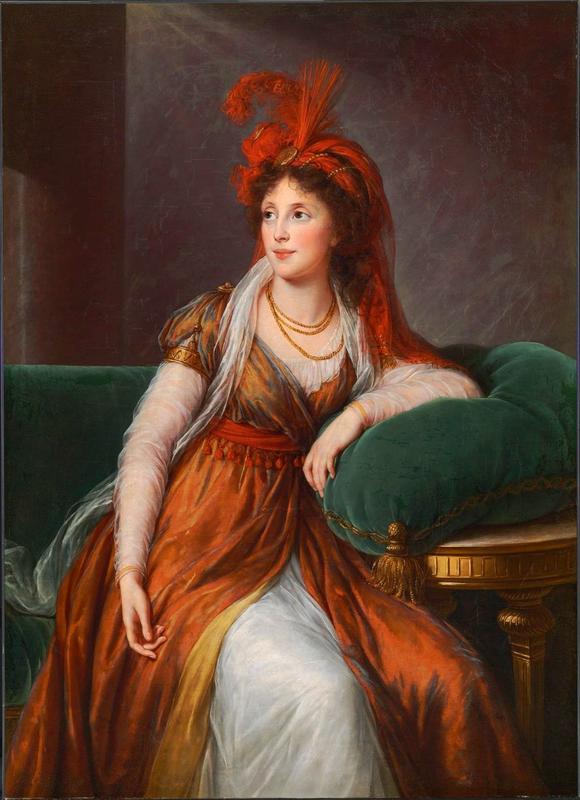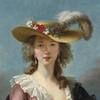More about Princess Anna Alexandrovna Galitzin

Sr. Contributor
Elisabeth Louise Vigée Le Brun painted a LOT of portraits.
Many of those portraits were images of people with titles, such as countess, princess, king (ex-king, but nobody wanted to tell him), queen; she even painted Marie Antoinette in a Blue Velvet Dress with White Skirt. Le Brun had previously painted Marie Antoinette as literally larger-than-life: a full-length portrait that measured over nine feet high by six feet wide.
Although Le Brun was born in France, she spent quite a bit of time outside the country, including a long period of exile. She ended up in Italy for three years, Austria for three years, Russia for six years, and finally Germany for one year before she returned to France. During her long stay in Russia, she had the opportunity to paint a number of portraits of the Russian royal extended family, and we know how extended those royal families can be. One such family was the Golitsyn clan; Le Brun painted Princess Evdokia Ivanovna Golitsyna as Flora, and of course, our subject, Princess Anna Alexandrovna Golitsyna.
Anna was the daughter of the tsarevich of Georgia, grew up in Moscow, and was a member of the house of Bagration-Gruzinsky, which meant the family had a good bit of local power. In 1785, she married Alexander Alexandrovich Litsyn, who was supposedly the illegitimate son of Prince Aleksander Mikhailovich Golitsyn. She was widowed in 1789, and a year later married another prince. This time it was Prince Boris Andreyevich Golitsyn, who just happened to be the first cousin of her deceased first husband. Anna and her new husband would go on to have eight children - one of them, Tatyana Borisovna Potemkina, would also be painted by Le Brun.
After about ten years, there was trouble in paradise. In 1798, her husband had been promoted to lieutenant general after Tsar Paul I took charge. Unfortunately, in 1800, it seems that Boris did something to piss off someone who was further up the ranks, leading to a sort of semi-exile. Anna and her family were compelled to “retire” to their estate at Sima, in the province of Vladimir, which, while being less than 200 kilometers northeast of Moscow, would have felt like Siberia to the princess.
Luckily for our heroine, she was soon back in the good graces of high society, when Alexander I came to power, and they were able to move back to St. Petersburg in 1801. Going back to 1797, when this portrait was commissioned, Le Brun’s prices were rumored to be very high. This would not be a problem for Princess Anna, however, as she was one of the wealthiest women in Russia. Believe it or not, the clothing Anna is wearing is thought to be “at home” wear, just a version of sweats and a t-shirt for the day. Apparently, the Russian aristocracy were not fans of showing too much skin, so it’s possible the sheer sleeves were added after the portrait was completed for modesty, as was done for the Grand Duchess Alexandra Pavlovna and Elena Pavlovna. Either way, Le Brun had it covered.
Sources
- Baetjer, K. (2016). Vigee Le Brun. Metropolitan Museum of Art.
- Clegg, M. (2020, May 2). Princess Anna Alexandrovna Golitsyna. Madame Guillotine. https://www.madameguillotine.co.uk/2020/05/02/princess-anna-alexandrovn….
- Montfort, Catherine R. “Self-Portraits, Portraits of Self: Adélaïde Labille-Guiard and Elisabeth Vigée Lebrun, Women Artists of the Eighteenth Century.” Pacific Coast Philology 40, no. 1 (2005): 1–18. http://www.jstor.org/stable/25474166.
- Tufts, Eleanor. “Vigée Le Brun.” Art Journal 42, no. 4 (1982): 335–38. https://doi.org/10.2307/776695.
- Vigee Le Brun Woman Artist in Revolutionary France. metmuseum.org. (n.d, from https://www.metmuseum.org/exhibitions/listings/2016/vigee-le-brun.
- Vigée-Lebrun Louise-Elisabeth. (1989). The memoirs of Elisabeth VIGÉE-Le Brun: Member of the Royal Academy of Paris, Rouen, Saint-Luke of Rome, Parma, Bologna, Saint-Petersburg, Berlin, Geneva and Avignon. Camden.











